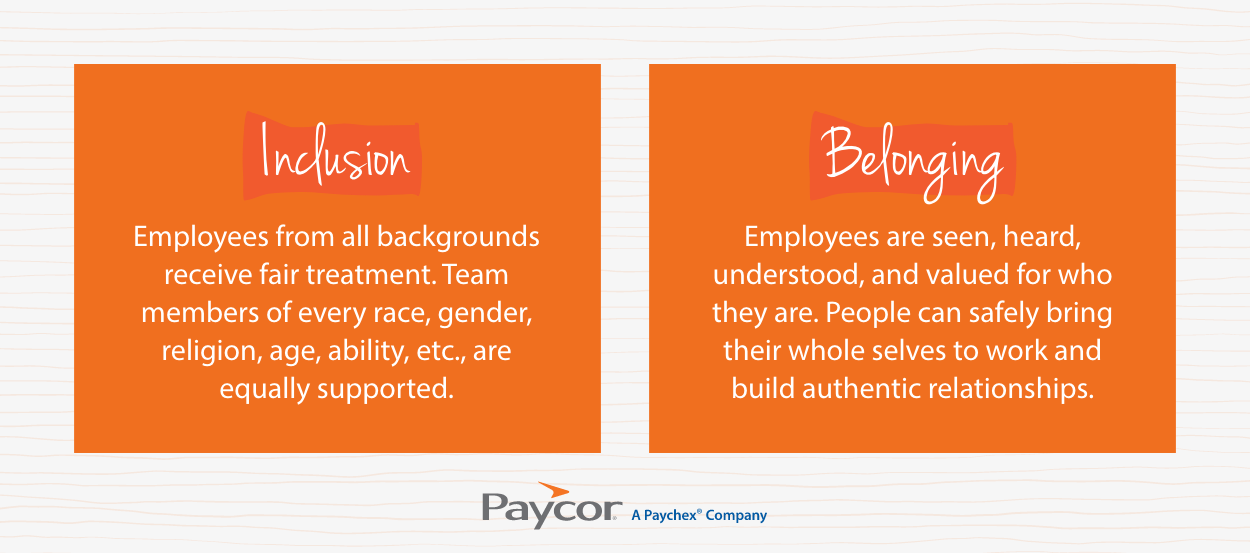At first, inclusion and belonging might seem like different words for the same HR goal. But there are some important distinctions between them. Understanding these nuances brings you a step closer to building a strong, effective, and sustainable workplace culture.
What’s the Difference Between Inclusion and Belonging?
Inclusion and belonging are both important aspects of company culture, and on the surface, they might sound identical. However, there are some key differences between these ideas.
Inclusion
Inclusionin the workplace ensures employees from all backgrounds receive fair treatment. That includes everyone on your team, regardless of gender, race, religion, age, ability, or any other identities. In an inclusive environment, team members of every demographic are equally supported and encouraged to grow their careers.
Belonging
Belonging goes a step further. In a culture of belonging, employees are safe to form authentic relationships. People feel seen, heard, understood, and valued for who they are. Belonging goes beyond tolerance and acceptance, celebrating each team member’s unique contributions. Employees can bring their whole selves to work without fear of judgment or retaliation.

Inclusion vs. Belonging: Why the Differences Matter
Your approach to belonging vs. inclusion impacts your company culture. If you muddy the waters between these ideas, you might not achieve either one. So how can HR leaders reach both goals?
Think of it this way: inclusion gets everyone in the room. Belonging determines whether they’ll feel safe to speak up once they’re there…and therefore, whether they’ll stay.
Research shows that companies with more demographically inclusive executive teams are 36% more likely to have above-average profitability (McKinsey). But inclusion alone doesn’t deliver those results. The magic happens when inclusive practices set the stage for genuine, company-wide belonging.
When employees feel they belong, they’re more engaged, more innovative, and significantly less likely to leave. According to one study, employees who feel they belong are nearly 2.4 times less likely to quit (Boston Consulting Group).
The business case is clear: inclusion sets the stage for business success, while belonging makes it sustainable.
Inclusion vs. Belonging at Work
HR sets the tone for company culture, but belonging and inclusion in the workplace are a team effort. Leaders should establish certain norms to make everyone in the organization feel welcome and valued. Approach this process with clear intentions and goals; otherwise, implicit bias and accidental exclusion can sneak up on you.
For example, does your company display images of senior executives that don’t include women and people of color? True, it may be “the way things are” at your organization, but those ambient cues can undermine people’s sense of belonging. It may cause members of underrepresented groups to doubt their future and the company’s willingness to invest in them.
Evaluate your current HR strategy and look for ways to cultivate inclusion and belonging. These examples can help you see what inclusion and belonging at work make look like:
In Team Meetings
Inclusion: Everyone should have equal opportunities to attend and participate. This could mean setting meetings at a time when all team members are available, providing translation services for non-native speakers, or using accessible technology for team members with disabilities. Use tools like Zoom or Slack to address any lurking proximity bias that may put remote workers at a disadvantage.
Belonging: Beyond just allowing for participation, leaders must foster an environment where everyone feels comfortable expressing their ideas. People should be safe to take risks without fear of judgment or reprisal. Get this right, and your team members will be actively engaged and feel their contributions are valued and impactful.
During Feedback and Recognition
Inclusion: Everyone’s voice should be heard. In an inclusive workplace, employees at all levels can easily provide feedback and be recognized for their work. Managers should conduct regular performance reviews, solicit 360-degree feedback, and promote peer recognition programs.
Belonging: Employees with a strong sense of belonging feel consistently valued and appreciated for their contributions. Recognition is personalized and sincere, showing workers how important they are to organizational success. Employees understand their role within the larger context of the organization’s mission and feel emotionally connected to key outcomes.
During Mentorship Programs
Inclusion: Inclusive teams give all employees access to mentorship and sponsorship programs, without bias or favoritism.
Belonging: Mentors and sponsors can foster belonging by showing genuine interest in their mentees’ personal and professional development. When mentors offer meaningful support, tailoring their advice to each person’s unique needs and aspirations, mentees will feel seen, understood, and supported on a personal level.
The Differences Between Inclusion vs. Belonging Within a Company
While inclusion and belonging work together to create strong company cultures, they have some fundamental differences that impact the company and overall strategy. These include:
Scope and Depth
Inclusion addresses structural barriers by implementing company-wide policies, practices, and systems. Leaders can cultivate inclusion by promoting concrete best practices like diverse hiring panels, regular compensation reviews, and accessible workplace accommodations.
Belonging addresses the emotional and psychological experiences of individual employees. To promote psychological safety, leaders should hone soft skills such as empathy and communication. HR can also offer implicit bias training.
Measurement & Assessment
Inclusion metrics are relatively straightforward. HR can track demographic representation, pay equity, promotion rates by demographic, and participation in key meetings and projects. These quantifiable data points show whether your inclusion policies are working.
Belonging requires more nuanced measurements. Employee engagement surveys can tell you whether people feel comfortable being themselves at work, whether they trust their colleagues, and whether they believe their perspectives add value.
Group vs. Individual Focus
Inclusion typically involves group-level initiatives. HR designs policies that benefit entire demographic categories. For example, you could institute parental leave for new parents, flexible scheduling for caregivers, employee resource groups for underrepresented populations, or religious accommodations for various faith traditions.
Inclusion also depends on concrete organizational action, which HR can mandate by usineinclusive hiring practices, establishing mentorship programs, and creating clear promotion criteria. You can weave inclusive practices into every policy, outline your expectations in the employee handbook, and hold leaders accountable for specific outcomes.
Belonging emerges more organically, through your organizational culture and countless daily interactions. HR can’t mandate belonging through a simple, straightforward policy. Belonging grows organically from genuine relationships, psychological safety, consistent follow-through, and proof that different perspectives genuinely influence company-wide decisions. Cultural change requires sustained effort across the entire organization.
Timeline for Results
Inclusion initiatives can demonstrate measurable progress relatively quickly. Within months of implementing new inclusive hiring practices, you can track improved representation in your candidate pools and employee demographics.
Belonging usually takes longer to develop. Building authentic belonging requires sustained effort and widespread emotional commitment. Give your team the time they need to build trust and cultivate authentic, supportive relationships.
The Impact of Inclusion and Belonging at Work
The most successful organizations prioritize both inclusion and belonging, recognizing the importance of both. Although inclusion creates the foundation of a strong company culture, belonging brings it to life.
In an ideal state, inclusion and belonging reinforce each other. According to a wealth of research, companies that address both dimensions see significant increases in engagement, retention, and business performance (SAP).
How to Bring Inclusion and Belonging Together
Start with inclusion. Audit your hiring, promotion, and compensation practices. Ensure employees of every demographic have equal access to internal opportunities. Implement policies that support diverse needs. Promote diversity through deliberate, transparent recruiting and promotion practices.
Next, layer in belonging. Train managers on soft skills that foster psychological safety, like empathy and communication. Encourage everyone on the team to have authentic conversations about different perspectives. Celebrate various cultural backgrounds by honoring diverse holidays or offering floating holidays as a benefit. Above all, demonstrate through consistent, daily actions that everyone on your team is important.
Use Paycor for Your Workplace’s Inclusion and Belonging
To foster a strong company culture, you need integrated systems that track progress, identify gaps, and equip leaders with actionable insights. Paycor’s unified HCM empowers leaders to drive inclusion, belonging, and business results.
Our Pulse Surveys measure both inclusion and belonging indicators across your organization, while Talent Management Software provides support for employees of every level. Paycor Paths helps your managers develop the soft skills they need to fight implicit bias and foster psychological safety.
When you incorporate belonging and inclusion into your core HR systems, you demonstrate your ongoing commitment to company culture. Ready to build a workplace where every employee feels safe, welcome, and inspired to grow?
Schedule a guided tour to see how Paycor can help.









